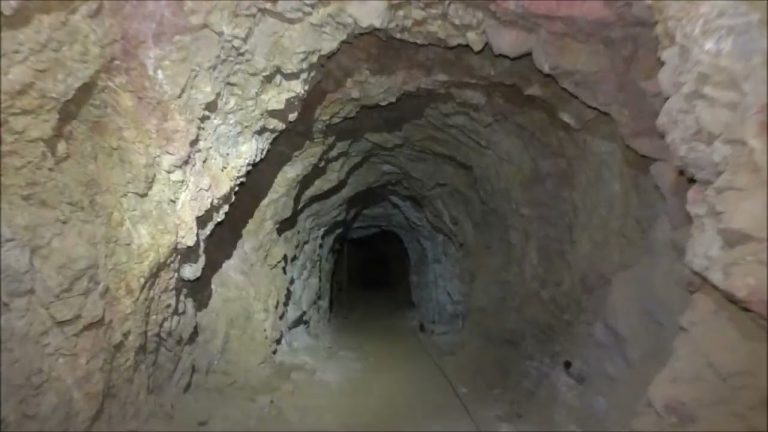Contaminated Land: The Environmental Burden Of Abandoned Gold Mines

Table of Contents
The Toxic Legacy of Gold Mining
Gold mining, while economically lucrative, leaves a devastating environmental footprint. The legacy of abandoned gold mines is one of widespread contamination, primarily through heavy metal pollution, acid mine drainage (AMD), and severe land degradation.
Heavy Metal Contamination
Gold mining releases a cocktail of heavy metals into the environment, including mercury, arsenic, lead, and cyanide. These toxic substances are primarily released from tailings – the waste material left after ore processing – and other mine waste.
- Sources: Tailings ponds, mine waste rock, abandoned mine shafts.
- Toxicity: Heavy metals bioaccumulate in the food chain, posing significant risks to human health (e.g., mercury poisoning causing neurological damage, arsenic leading to cancer) and harming wildlife through poisoning and habitat destruction. Lead contamination can cause developmental problems in children. Cyanide is acutely toxic to aquatic life.
- Long-term effects: Persistent heavy metal contamination in soil and water can last for centuries, requiring extensive and costly remediation efforts. The long-term effects of heavy metal contamination on ecosystems can be irreversible.
Acid Mine Drainage (AMD)
Acid mine drainage is a severe form of water pollution resulting from the oxidation of sulfide minerals present in mine waste. This process generates sulfuric acid, which dissolves heavy metals and other toxic substances, leaching them into surrounding water bodies.
- Chemical reactions: Exposure of sulfide minerals (like pyrite) to air and water triggers chemical reactions that produce sulfuric acid (H2SO4).
- Impact on aquatic life: AMD dramatically lowers the pH of water, making it highly acidic and uninhabitable for most aquatic organisms. The dissolved heavy metals further contaminate the water, poisoning fish and other aquatic life. This acid mine drainage remediation is a huge challenge.
- Challenges of AMD remediation: AMD remediation requires costly and complex treatment methods, often involving neutralization of the acidic water and removal of dissolved heavy metals.
Land Degradation and Erosion
Mining activities cause significant physical damage to the landscape, leading to deforestation, soil erosion, and extensive scarring.
- Loss of biodiversity: Habitat destruction resulting from mining leads to loss of biodiversity and disruption of ecological processes.
- Impacts on agriculture: Soil contamination and erosion render land unsuitable for agriculture, impacting food security for local communities.
- Visual impacts: The scarred landscape left behind by abandoned mines poses significant visual impacts on the environment, degrading the aesthetic value of the area. Land reclamation and mine site rehabilitation are essential to restore these areas.
The Extent of the Problem: Global Impacts of Abandoned Gold Mines
The problem of abandoned gold mines and the resulting contaminated land is global in scope, with severe consequences for numerous regions.
Geographic Distribution
Abandoned gold mines are prevalent worldwide, with significant concentrations in regions with a long history of gold mining. Examples include:
- Latin America: Many countries in Latin America have a legacy of uncontrolled gold mining, resulting in widespread contamination.
- Africa: Artisanal and small-scale gold mining in Africa often lacks environmental safeguards, leading to severe pollution.
- North America: The historical gold rushes in North America left behind many abandoned mines, requiring extensive remediation efforts.
The sheer number of abandoned mines globally underscores the magnitude of the environmental problem.
Socioeconomic Impacts
The presence of contaminated land from abandoned gold mines severely impacts local communities.
- Community health: Exposure to heavy metals and other toxins through contaminated water and soil leads to various health problems, including cancer, neurological disorders, and developmental problems in children.
- Economic hardship: Contaminated land reduces the productive capacity of the land, impacting agriculture and other economic activities. This can lead to poverty and displacement.
- Environmental justice: The disproportionate impact of abandoned gold mines on marginalized communities raises serious concerns about environmental justice.
Remediation and Mitigation Strategies for Contaminated Land
Addressing the environmental burden of abandoned gold mines requires a multi-faceted approach incorporating technological solutions and robust regulatory frameworks.
Technological Solutions
Various technologies are employed in the remediation of abandoned gold mines, including:
- Phytoremediation: Using plants to absorb and remove contaminants from the soil and water. This is a sustainable and cost-effective method for certain contaminants.
- Bioremediation: Utilizing microorganisms to break down contaminants, offering a natural and environmentally friendly approach.
- Physical removal of contaminated materials: This involves excavating and disposing of heavily contaminated soil and waste materials in a safe manner. This method is costly but effective for highly contaminated sites.
- Passive treatment systems: Using natural processes to treat AMD, such as constructed wetlands or bioreactors. This represents a sustainable, long-term solution.
The choice of technology depends on the specific contaminants, site conditions, and available resources.
Regulatory Frameworks and Policy
Effective environmental regulations and international agreements are crucial in preventing further contamination and promoting remediation of abandoned gold mines.
- Mine closure plans: Requiring comprehensive mine closure plans that address potential environmental liabilities before mining commences.
- Environmental impact assessments: Rigorous environmental impact assessments to identify and mitigate potential risks.
- Financial assurance mechanisms: Establishing mechanisms to ensure that mining companies have the financial resources to cover the costs of remediation.
- International cooperation: Strengthening international cooperation to share best practices and support capacity building in developing countries.
Conclusion
Abandoned gold mines represent a significant environmental burden, leaving behind contaminated land with long-lasting impacts on ecosystems and human health. The widespread heavy metal pollution, acid mine drainage, and land degradation necessitate urgent action. Addressing the environmental burden of abandoned gold mines requires a multifaceted approach, incorporating advanced remediation technologies, strong regulatory frameworks, and international collaboration. Learn more about contaminated land remediation and get involved in supporting sustainable mining practices and the cleanup of existing contaminated sites from abandoned gold mines. Support organizations working on mine remediation and advocate for policies that promote responsible mining practices and hold mining companies accountable for their environmental legacy. Remember, responsible action today is crucial to prevent the creation of more contaminated land in the future.

Featured Posts
-
 How Aritzia Is Navigating Trump Tariffs Without Raising Prices
May 06, 2025
How Aritzia Is Navigating Trump Tariffs Without Raising Prices
May 06, 2025 -
 Sukces Nitro Chem Polski Trotyl Dla Wojska Amerykanskiego
May 06, 2025
Sukces Nitro Chem Polski Trotyl Dla Wojska Amerykanskiego
May 06, 2025 -
 Tallulah Willis Rare Comments On Ex Stepfather Ashton Kutcher
May 06, 2025
Tallulah Willis Rare Comments On Ex Stepfather Ashton Kutcher
May 06, 2025 -
 Stephen A Smith Pays Tribute To Gregg Popovichs Coaching Legacy
May 06, 2025
Stephen A Smith Pays Tribute To Gregg Popovichs Coaching Legacy
May 06, 2025 -
 Patrick Schwarzenegger Addresses White Lotus Casting Rumors His Perspective
May 06, 2025
Patrick Schwarzenegger Addresses White Lotus Casting Rumors His Perspective
May 06, 2025
